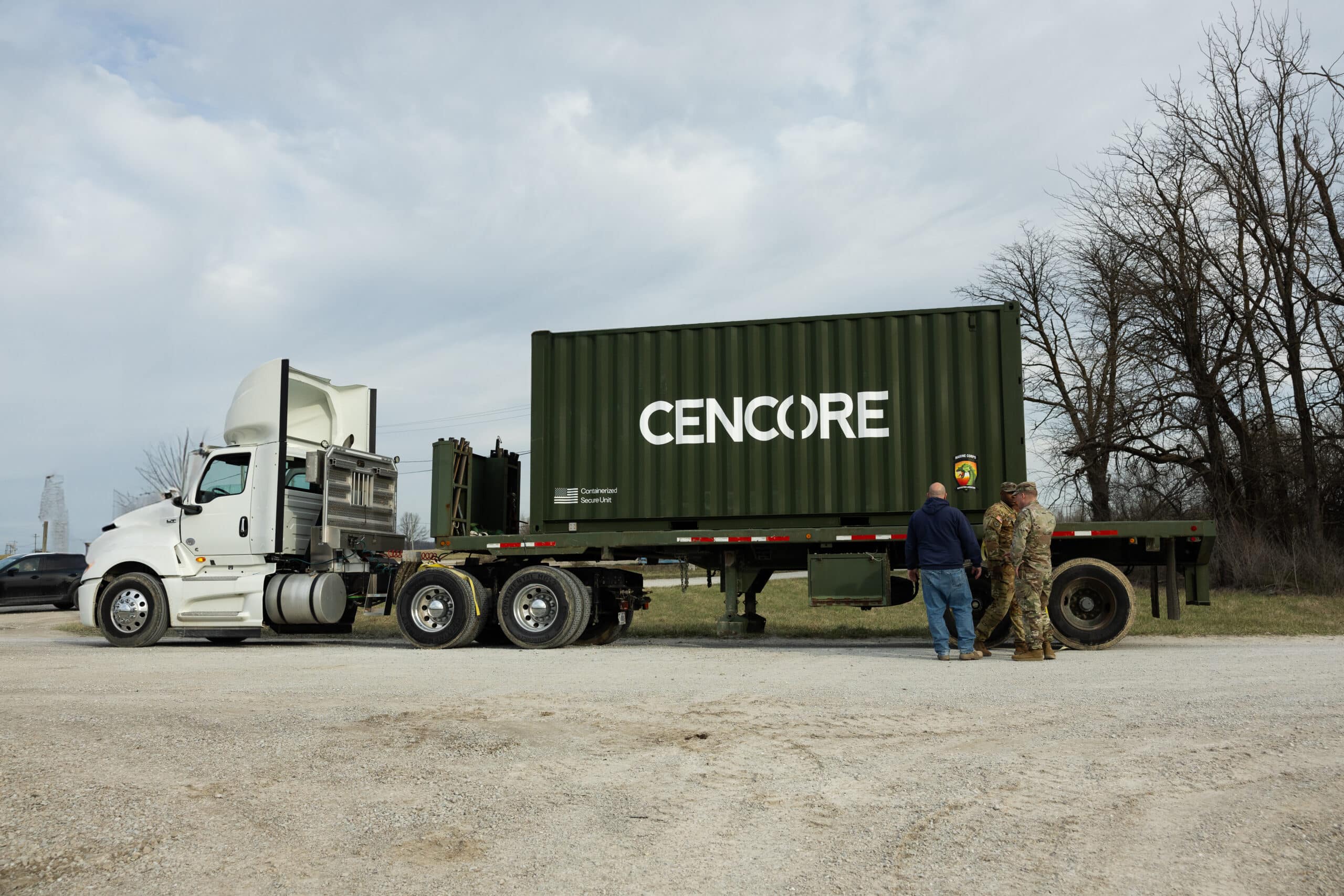Three (3) Reasons Containerized SCIFs Make Sense
The modern battlefield extends far beyond traditional combat zones into cyber domains, urban environments, and contested spaces where security infrastructure must adapt at mission speed. Legacy-era SCIF (Sensitive Compartmented Information Facility)-anchored operations that are fixed to physical locations can often create strategic vulnerabilities in today’s era demanding operational agility and rapid response capabilities.
Container SCIF technology transforms security infrastructure from static liability into strategic assets. Where traditional SCIFs require permanent installation and months of construction, modular SCIF solutions deliver enterprise-grade security with the mobility and deployment speed that modern operations demand.
CenCore’s mission to Mobilize America’s Industrial Base through intelligent repurposing finds perfect expression in containerized security solutions. The same commercial manufacturing capabilities producing shipping containers and modular facilities now create military-grade secure workspaces that deploy anywhere, anytime. This dual-use approach eliminates the artificial barriers between commercial innovation and defense requirements, delivering capabilities at commercial speed with military precision.
The convergence of advanced materials science, cybersecurity innovation, and modular manufacturing has created the perfect conditions for SCIF container units to emerge as the dominant solution for forward operations, rapid response scenarios, and cost-effective security implementations across the defense industrial base.
Reason 1: Modular SCIF Deployment-Speed Transforms Operational Capability
Traditional SCIF deployment follows an antiquated timeline incompatible with modern operational requirements. Site surveys, architectural planning, security coordination, contractor selection, and construction phases stretch across months while missions wait for secure workspace capability. This approach serves static operational models but fails catastrophically in dynamic threat environments.
Container SCIF technology eliminates deployment bottlenecks through pre-certified, mission-ready units that arrive with integrated power systems, environmental controls, and validated security infrastructure. What previously required 6-12 months of planning and construction now deploys within 48-72 hours of mission authorization.
Special operations forces (SOF) exemplify the deployment advantage. Forward-deployed teams require immediate secure communications capability in contested environments where traditional infrastructure is unavailable or compromised. Modular SCIF solutions provide instant secure workspace, enabling real-time intelligence processing and secure communications without operational delays or security compromises.
The deployment advantage extends beyond speed to operational flexibility. Container-based systems operate independently of local infrastructure while integrating seamlessly with existing facilities. This self-sufficiency proves critical in environments where power grids may be unreliable, communication networks compromised, or physical security uncertain.
Combat support agencies, disaster response teams, and intelligence operations all benefit from security infrastructure that adapts to mission requirements rather than constraining them. SCIF container units provide commanders with tactical flexibility impossible with fixed installations, enabling secure operations in austere environments, temporary forward bases, and rapidly changing operational theaters.
The ability to pre-position secure workspace capabilities creates strategic advantages. Units deployed during peacetime can immediately support crisis response operations without construction delays or security certification processes. This readiness posture transforms security infrastructure from operational constraint into a force multiplier.
Reason 2: Economic Efficiency Enables Strategic Proliferation
Traditional SCIF economics create artificial scarcity in security infrastructure. Site-specific designs, specialized contractors, and permanent construction requirements drive individual facility costs into millions of dollars. These investments make financial sense for permanent installations but become prohibitive for temporary operations, distributed teams, or emerging mission requirements.
Container SCIF solutions fundamentally restructure the economic equation through manufacturing standardization and deployment flexibility. Our Secure-Scalability enables lower costs impossible with site-specific construction, reducing per-unit costs while maintaining security performance standards. Multiple identical units share development costs, making secure workspace accessible to programs previously excluded by traditional construction expenses.
Operational economics favor modular SCIF deployment through reduced lifecycle costs and simplified logistics. Traditional SCIFs require specialized maintenance teams familiar with unique site configurations. Container-based systems use standardized components and procedures, reducing training requirements, parts inventory, and maintenance complexity across the entire fleet.
Financial flexibility represents another significant advantage. Organizations can lease SCIF container units for specific mission durations, avoiding capital expenditure requirements while maintaining access to enterprise-grade security infrastructure. This approach aligns perfectly with modern acquisition strategies prioritizing capability access over asset ownership.
Risk mitigation delivers substantial cost advantages over traditional construction approaches. Fixed construction carries completion risk, cost overrun potential, and technology obsolescence concerns. Container-based solutions eliminate construction risk while providing technology refresh capabilities that maintain current security standards against evolving threats.
The economic efficiency of modular SCIF technology enables strategic proliferation of secure workspace capabilities across the defense industrial base. Lower costs and deployment flexibility make security infrastructure available to smaller programs, distributed teams, and emerging mission requirements previously underserved by expensive fixed installations.
Reason 3: Superior Container SCIF Security Through Controlled Manufacturing and Standardization
Security effectiveness depends on consistent implementation of proven protective measures without compromise or variation. Traditional SCIF construction introduces variables through site-specific designs, local contractors, and field modifications that create potential vulnerabilities. Each facility becomes unique, requiring individual security assessments and creating maintenance challenges that can degrade protective effectiveness over time.
Container SCIF technology leverages-controlled manufacturing environments to achieve superior security through precise implementation of validated protective measures. Factory production ensures exact compliance with TEMPEST requirements, acoustic isolation standards, and physical security specifications without field construction variables that can compromise security performance.
The controlled manufacturing environment enables integration of advanced security technologies impractical in traditional construction scenarios. Precision electromagnetic shielding, integrated sensor systems, and advanced materials become standard features rather than custom additions. This approach ensures every modular SCIF deployment benefits from cutting-edge security innovations.
Standardization enhances operational security through consistent training and procedures. Personnel familiar with one SCIF container unit can effectively operate any unit in the fleet, reducing human error risks and improving security compliance. Uniform interfaces, procedures, and capabilities create operational advantages extending beyond individual facility performance.
Mobile security infrastructure provides unique advantages in dynamic threat environments. Fixed installations become predictable targets over time, while relocatable secure workspace maintains operational unpredictability that complicates adversary planning and surveillance efforts. The ability to rapidly relocate sensitive operations creates strategic deception opportunities impossible with permanent installations.
Quality control processes validate every system before deployment, eliminating field construction variables that can compromise security effectiveness. Factory testing ensures electromagnetic compliance, physical security integrity, and environmental system performance before units reach operational deployment.
The Strategic Revolution: From Infrastructure Constraint to Operational Enabler
Modern conflict demands security infrastructure that enhances rather than constrains operational capability. Traditional approaches prioritizing permanence over agility create strategic vulnerabilities in rapidly evolving threat environments. Container SCIF technology represents the intelligent evolution of security infrastructure to match the pace and complexity of contemporary operations.
The defense industrial base requires infrastructure strategies that leverage commercial innovation rather than reinventing proven solutions. CenCore’s vision to Mobilize America’s Industrial Base and expanding its capacity through dual-use applications finds perfect expression in modular SCIF solutions. Commercial manufacturing capabilities producing shipping containers and modular facilities adapt seamlessly to create military-grade security infrastructure at commercial speed and cost.
Horizontal integration across defense programs creates multiplier effects impossible with traditional construction approaches. SCIF container units developed for one mission can support multiple programs, creating economies of scale and reducing mission and organizational costs across the entire defense enterprise. This approach maximizes return on investment while proliferating secure workspace capabilities.
The paradigm shift from static to mobile security infrastructure aligns with broader military transformation toward distributed operations, multi-domain warfare, and great power competition. Container-based solutions provide the flexibility, cost-effectiveness, and security performance necessary to maintain technological superiority in contested environments where traditional infrastructure becomes a liability rather than an asset.
Organizations adopting modular SCIF technology gain competitive advantages through enhanced operational flexibility, reduced deployment timelines, and superior cost performance. The question facing defense leadership is not whether containerized security will replace traditional construction, but how quickly they will adapt to gain strategic advantages through intelligent infrastructure modernization.
Victory in future conflicts will favor forces that integrate commercial innovation with military requirements, deploy capabilities at commercial speed, and maintain operational unpredictability through mobile infrastructure. Container SCIF technology delivers all three advantages while ensuring America’s most sensitive operations maintain the security standards essential for mission success.
See how our Containerized Secure Units deliver speed, security, and flexibility for modern operations.
About CenCore
CenCore is a leading provider of cleared staffing solutions, advanced technology modular platforms and proximity-based services to the defense, enterprise business and intelligence communities. With deep expertise in supporting critical national security missions, CenCore connects top-tier cleared professionals with organizations driving innovation in defense technology, cybersecurity, and intelligence operations. Our commitment to excellence ensures that America’s most vital programs have access to the skilled workforce, and secure platforms in time and on-site to maintain technological superiority and operational readiness for the warfighter.




